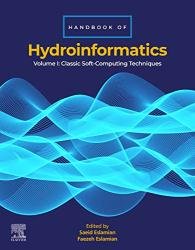Handbook of HydroInformatics: Volume I: Classic Soft-Computing Techniques
- Добавил: literator
- Дата: 23-12-2022, 03:27
- Комментариев: 0
 Название: Handbook of HydroInformatics: Volume I: Classic Soft-Computing Techniques
Название: Handbook of HydroInformatics: Volume I: Classic Soft-Computing TechniquesАвтор: Saeid Eslamian, Faezeh Eslamian
Издательство: Elsevier
Год: 2023
Страниц: 484
Язык: английский
Формат: pdf (true)
Размер: 43.1 MB
Classic Soft-Computing Techniques is the first volume of the three, in the Handbook of HydroInformatics series. Through this comprehensive, 34-chapters work, the contributors explore the difference between traditional computing, also known as hard computing, and soft computing, which is based on the importance given to issues like precision, certainty and rigor. The chapters go on to define fundamentally classic soft-computing techniques such as Artificial Neural Network, Fuzzy Logic, Genetic Algorithm, Supporting Vector Machine, Ant-Colony Based Simulation, Bat Algorithm, Decision Tree Algorithm, Firefly Algorithm, Fish Habitat Analysis, Game Theory, Hybrid Cuckoo–Harmony Search Algorithm, Honey-Bee Mating Optimization, Imperialist Competitive Algorithm, Relevance Vector Machine, etc. It is a fully comprehensive handbook providing all the information needed around classic soft-computing techniques.
The Chapter 1 describes different types of regressions and how they can be used to solve real problems. To solve our challenges in different sections, we utilize the Scikit-learn Python library. In this chapter, a complete description of different regressions such as robust, multiple, regulized (ridge, lasso, and elastic net), polynomial, and logistic is given. Introduction and practical use of methods such as gradient descent, cross-validation, and the learning curve are illustrated and how to deal with issues such as outliers, overfitting, and underfitting to have a better approach to regression issues became clear.
Bayesian law expresses the relationship between dependent variables. The Bayesian relation uses a numerical estimate of the probabilistic knowledge of the hypothesis before the observations occur, and provides a numerical estimate of the probabilistic knowledge of the hypothesis after the observations. This law for classifying phenomena is based on the probability of occurrence or nonoccurrence of a phenomenon and is important and widely used in probability theory. If we can choose such a separation for a given sample space that knowing which of the separated events occurred would reduce an important part of the uncertainty. This is useful because it can be used to calculate the probability of an event being conditional on the occurrence or nonoccurrence of another event. In many cases, it is difficult to calculate the probability of an incident directly. Using this theorem and conditioning one event on another, the probability can be calculated. Bayesian theory has three methods: Bayes Optimal Classifier, Naive Bayes classifier, and Bayesian network. In hydrological issues, the Bayesian network has been used more. These networks are graphical networks that represent a set of possible variables and their conditional dependencies by a directional noncyclic graph (DAG). Bayesian network nodes represent variables that can be visible values, hidden variables, or unknown parameters. The edges of this network indicate dependencies. Each node has a probability function that includes the initial probability (for parentless nodes) or conditional probabilities related to the combination of different states of the parent nodes.
This volume is a true interdisciplinary work, and the audience includes postgraduates and early career researchers interested in Computer Science, Mathematical Science, Applied Science, Earth and Geoscience, Geography, Civil Engineering, Engineering, Water Science, Atmospheric Science, Social Science, Environment Science, Natural Resources, and Chemical Engineering.
Key insights from global contributors in the fields of data management research, climate change and resilience, insufficient data problem, etc.
Offers applied examples and case studies in each chapter, providing the reader with real world scenarios for comparison.
Introduces classic soft-computing techniques, necessary for a range of disciplines.
Скачать Handbook of HydroInformatics: Volume I: Classic Soft-Computing Techniques
Внимание
Уважаемый посетитель, Вы зашли на сайт как незарегистрированный пользователь.
Мы рекомендуем Вам зарегистрироваться либо войти на сайт под своим именем.
Уважаемый посетитель, Вы зашли на сайт как незарегистрированный пользователь.
Мы рекомендуем Вам зарегистрироваться либо войти на сайт под своим именем.
Информация
Посетители, находящиеся в группе Гости, не могут оставлять комментарии к данной публикации.
Посетители, находящиеся в группе Гости, не могут оставлять комментарии к данной публикации.
